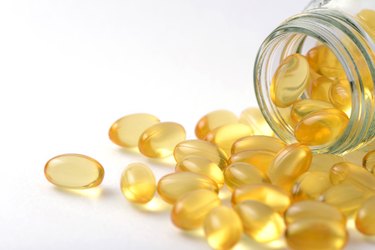
Vitamin D is the sunshine vitamin. Most people, however, don't get enough sun exposure, especially during the cold months. Living anywhere north of the latitude of Atlanta virtually assures you're not getting enough vitamin D from the sun in winter. One solution is to take supplements, but with a caveat.
Excessive Urination and Vitamin D
Video of the Day
Vitamin D is fat soluble, meaning that, unlike some vitamins, it can't be excreted through urination. If you take too much, it can cause your blood to retain calcium and lead to a health condition known as hypercalcemia — or excessive levels of calcium in your blood, which can lead to frequent urination. Other early warning signs of hypercalcemia include:
Video of the Day
- Nausea and vomiting
- A loss of appetite
- Confusion, disorientation or trouble thinking
Hypercalcemia happens when you have 10.4 milligrams of calcium per deciliter of blood. That may not seem like a lot, but it's enough to cause problems. Too much vitamin D can also cause your bones to release calcium into the bloodstream, which may affect bone health. If you have these symptoms and suspect high levels of vitamin D, see a doctor. You may simply have to cut back on vitamin D, limit your calcium intake and be diligent about drinking water.
Vitamin D Overdose
Other complications of too much vitamin D include bone pain, kidney problems and even calcium stone formation. Headaches, exhaustion, irregular heartbeat and high blood pressure are other serious signs. One side effect you probably won't see with excess vitamin D is a bright yellow color in your urine. This is often caused by too much vitamin B and may be caused by a multivitamin.
Read More: Can Vitamins Change the Color of Your Urine?
Vitamin D Recommendations
Most people under 70 years of age need 600 IU (international units) of Vitamin D each day. Infants up to 1 year of age should get 400 IU. You can take that in a supplement, get it in your diet, or both. Good sources of vitamin D include:
- The flesh of fatty fish (salmon, tuna and mackerel) and fish liver oils
- Beef liver
- Cheese
- Egg yolks
You can also get vitamin D from fortified foods like milk, ready-to-eat cereals, some yogurt and plant-based milk alternatives. These will be marked on the label.
Most people, however, don't get enough vitamin D from food alone. Supplements do help most people. Many, especially women, need vitamin D to prevent osteoporosis, a bone-thinning disease. Low levels of vitamin D contribute to osteoporosis by reducing calcium absorption.
Vitamin D supplements may help those with have an overactive bladder, a condition that interestingly may occur more often during the winter months. A study published in the urology journal BJU International noted that overactive bladder symptoms were reduced after patients were given vitamin D supplements.
How Much Is Too Much?
The problem with vitamin D is knowing how much is enough. The toxicity threshold is considered to be 10,000 to 40,000 IU per day (according to NIH). Tolerable upper intake levels are considered to be 3,000 IU in children ages 4 to 8, and 4,000 IU for adults and in children age 9 and older.
So if you're taking vitamin D supplements above those levels, you might be in for adverse health effects like excessive urination and hypercalcemia. The best way to stop hypercalcemia before it gets serious, or to prevent it, is to reduce your daily dose of vitamin D.
Vitamin D and Winter
Depending on where you live and the amount of time you spend outside, you may only need to supplement with vitamin D in the winter. Vitamin D levels drop in winter due to a lack of ultraviolet B (UVB) exposure, which is the wavelength of light that triggers your skin to produce vitamin D. If you live above latitude 40 degrees north, such as in New York City, your winter lasts from November to March.
At latitude 35 degrees north, such as in North Carolina, so-called "vitamin D winter" is December to February. During these months, the sun level simply isn't high enough to stimulate vitamin D production.
If you're dark-skinned, you'll have a hard time absorbing sunlight rays, which may contribute to a vitamin D deficiency. But again, when supplementing, stick to the recommended daily limits and be careful not to go overboard.
- The Mayo Clinic: What is Vitamin D Toxicity and Should I Worry About it Since I Take Supplements?
- BJU International: Impact of Serum 25-OH Vitamin D Level on Lower Urinary Tract Symptoms in Men: A Step Towards Reducing Overactive Bladder
- Medical News Today: Can Too Much Vitamin D Hurt You?
- National Institutes of Health Office of Dietary Supplements: Vitamin D
- Endocrine Abstracts: Vitamin D Intoxication Caused Hypercalcemia: Case Report
- DrGangemi.com: Get Ready for Your Vitamin D Winter
- Sunsafe Rx: Vitamin D and Sunlight: How to Know if Your Sun Exposure is Producing Vitamin D